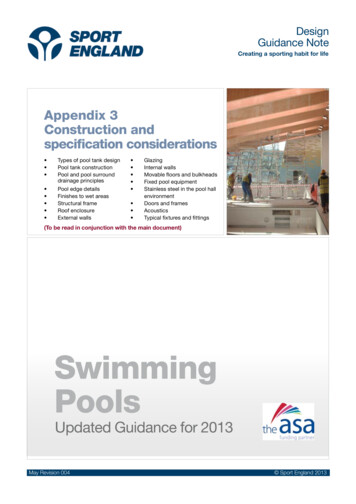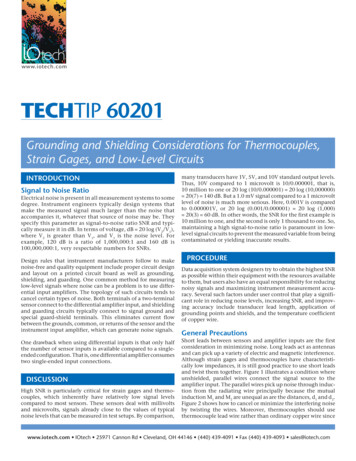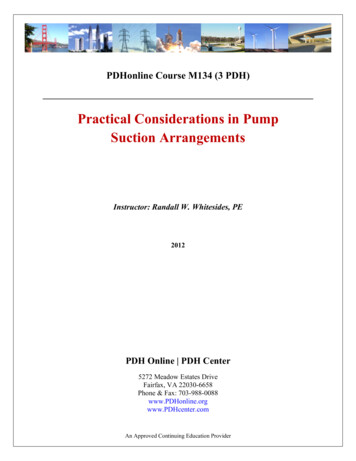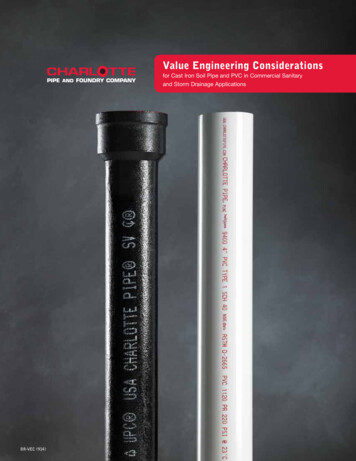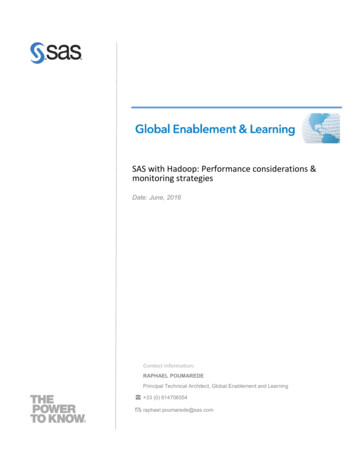
Transcription
White PaperConsiderations for Using T.38 versus G.711 for Fax over IP
Considerations for Using T.38 versus G.711 for Fax over IPWhite PaperExecutive SummaryBusinesses migrating to Voice over IP (VoIP) often find it desirable to move their fax traffic onto the IP network as well. However,VoIP networks are, as the name implies, optimized for voice traffic; and businesses implementing a Fax over IP (FoIP) solution aspart of their fax system can benefit from understanding their options for FoIP transport methods.This white paper compares the performance of the two principal options for sending faxes over an IP network: T.38 fax relayand G.711 fax pass-through. The V.17 and V.34 modem standards are briefly discussed and also used for comparison when usedwith T.38 and G.711 for performance against IP network impairments, such as latency, packet loss, and jitter. The impact of thesenetwork impairments on call control, fax control, and image data are described, as well as the impact of the frequency of theseimpairments. General considerations for network performance are also covered, as are sections describing how metrics withinthe Dialogic Brooktrout Bfv API can be used to detect IP network impairments.2
Considerations for Using T.38 versus G.711 for Fax over IPTable of ContentsIntroduction . . . . . . . . . . . . . . . . . . . . . . . . . . . . . . . . . . . . . . . . . . . . . . . . . . . . . . . . . . . . . . . . . . . . . . . . . . . . . . . . 4FoIP Transport Methods . . . . . . . . . . . . . . . . . . . . . . . . . . . . . . . . . . . . . . . . . . . . . . . . . . . . . . . . . . . . . . . . . . . . . . 4T.38 versus G.711 . . . . . . . . . . . . . . . . . . . . . . . . . . . . . . . . . . . . . . . . . . . . . . . . . . . . . . . . . . . . . . . . . . . . . . . 4V.17 versus V.34 . . . . . . . . . . . . . . . . . . . . . . . . . . . . . . . . . . . . . . . . . . . . . . . . . . . . . . . . . . . . . . . . . . . . . . . . . 5Redundancy . . . . . . . . . . . . . . . . . . . . . . . . . . . . . . . . . . . . . . . . . . . . . . . . . . . . . . . . . . . . . . . . . . . . . . . . . . . 5ECM . . . . . . . . . . . . . . . . . . . . . . . . . . . . . . . . . . . . . . . . . . . . . . . . . . . . . . . . . . . . . . . . . . . . . . . . . . . . . . . . . 5Typical IP Network Impairments . . . . . . . . . . . . . . . . . . . . . . . . . . . . . . . . . . . . . . . . . . . . . . . . . . . . . . . . . . . . . . . . 5Latency . . . . . . . . . . . . . . . . . . . . . . . . . . . . . . . . . . . . . . . . . . . . . . . . . . . . . . . . . . . . . . . . . . . . . . . . . . . . . . . 5Packet Loss . . . . . . . . . . . . . . . . . . . . . . . . . . . . . . . . . . . . . . . . . . . . . . . . . . . . . . . . . . . . . . . . . . . . . . . . . . . . 6Jitter . . . . . . . . . . . . . . . . . . . . . . . . . . . . . . . . . . . . . . . . . . . . . . . . . . . . . . . . . . . . . . . . . . . . . . . . . . . . . . . . . 6Impact of Network Impairments . . . . . . . . . . . . . . . . . . . . . . . . . . . . . . . . . . . . . . . . . . . . . . . . . . . . . . . . . . . . . . . .6Call Control . . . . . . . . . . . . . . . . . . . . . . . . . . . . . . . . . . . . . . . . . . . . . . . . . . . . . . . . . . . . . . . . . . . . . . . . . . . 7Fax Control . . . . . . . . . . . . . . . . . . . . . . . . . . . . . . . . . . . . . . . . . . . . . . . . . . . . . . . . . . . . . . . . . . . . . . . . . . . . 7Image Data . . . . . . . . . . . . . . . . . . . . . . . . . . . . . . . . . . . . . . . . . . . . . . . . . . . . . . . . . . . . . . . . . . . . . . . . . . . . 7Impairment Frequency . . . . . . . . . . . . . . . . . . . . . . . . . . . . . . . . . . . . . . . . . . . . . . . . . . . . . . . . . . . . . . . . . . 7Observed Impacts of Network Impairment . . . . . . . . . . . . . . . . . . . . . . . . . . . . . . . . . . . . . . . . . . . . . . . . . . . . . . . 7Effects of Single Packet loss . . . . . . . . . . . . . . . . . . . . . . . . . . . . . . . . . . . . . . . . . . . . . . . . . . . . . . . . . . . . . . 7Considerations for Network Performance . . . . . . . . . . . . . . . . . . . . . . . . . . . . . . . . . . . . . . . . . . . . . . . . . . . . . . . 13Dialogic Brooktrout SR140 Fax Software . . . . . . . . . . . . . . . . . . . . . . . . . . . . . . . . . . . . . . . . . . . . . . . . . . . . . . 14Appendix – Detecting Network Issues using Fax Quality Metrics . . . . . . . . . . . . . . . . . . . . . . . . . . . . . . . . . . . 14Performance-Improving Features . . . . . . . . . . . . . . . . . . . . . . . . . . . . . . . . . . . . . . . . . . . . . . . . . . . . . . . . . . . . . .14References . . . . . . . . . . . . . . . . . . . . . . . . . . . . . . . . . . . . . . . . . . . . . . . . . . . . . . . . . . . . . . . . . . . . . . . . . . . . . . . . 18For More Information . . . . . . . . . . . . . . . . . . . . . . . . . . . . . . . . . . . . . . . . . . . . . . . . . . . . . . . . . . . . . . . . . . . . . . . 183White Paper
Considerations for Using T.38 versus G.711 for Fax over IPWhite PaperIntroductionIn the 1990s, “fax” and “T.30” were so entwined that they were basically synonymous. T.30, as the ITU recommendation for transmitting faxesover the general switched telephone network, includes mechanisms to handle background noise and spikes of interference on the telephoneline. For example, poor signal quality can be accommodated by lowering the transmission speed, and spikes of noise can be handled by retryingany operations that are lost during the spike.But T.30 was not designed to deal with IP network impairments such as packet loss, which can result in large gaps in fax data and cannot beeliminated by a lower transmission speed. In fact, lower speeds may actually make the performance worse by generating additional networktraffic that will be exposed to packet loss. And retries might not always recover missed data when packet loss is frequent, because the retries cansuffer packet loss as well. Even the retry requests themselves may be lost.When upgrading from traditional analog fax to a Fax over IP (FoIP) solution, it is necessary to provide a sufficient level of network performance tosupport reliable operation. Fax transport over an IP network can be provided by T.38 fax relay and G.711 pass-through, each one having differentnetwork requirements for reliable operation.This white paper describes and compares the T.38 and G.711 fax transport methods for FoIP, using both V.17 and V.34 modem standards, forperformance against typical IP network impairments, such as latency, packet loss, and jitter. It then discusses the impact of these networkimpairments on call control, fax control, and image data, as well as the impact of the frequency of these impairments. This paper also providesconsiderations for network performance for each fax transport method, and includes information pertaining to the ways metrics within theDialogic Brooktrout Bfv API can be used to detect IP network impairments.FoIP Transport MethodsWhen implementing a FoIP solution, the transport method used (T.38 or G.711), in addition to several fax settings such as fax speed, redundancy,and error correction, can have a significant impact on FoIP performance for common network impairments.T.38 versus G.711T.38 fax relay is an ITU-T recommendation that allows for fax data to be carried over IP networks. Data is transmitted directly in T.38 without beingconverted to an audio stream, which results in a significant reduction in the bandwidth needed. T.38 also supports data and controls redundancyto mitigate the effects of packet loss.One disadvantage of T.38 is that gateway support for fax parameters, such as V.34 transmission speed and Error Correction Mode (ECM), is notuniversal. Also, in the current mixed network environment of packet-based and circuit-switched (that is, PSTN) connections, T.38 often has atranscoding overhead. That can add latency and cost to fax services.G.711 is an ITU-T recommendation for Pulse Code Modulation (PCM) of voice frequencies. It uses an uncompressed format and requires highbandwidth, typically about 64 kbps. Using G.711 as the transport method for FoIP is an extension of traditional PSTN audio-based faxing. Thedigital fax data is converted to a PCM audio stream and then sent as G.711 Real-time Transport Protocol (RTP) packets.G.711 has not been optimized for fax transport over IP networks, and does not typically support packet redundancy. Having been developed forvoice, G.711 allows the transmission of missing audio because any gaps would be filled in by a human listener. But when used to transmit modemdata, any loss of packets is significant, because the receiver has no way to recreate the missing data.Some packet networks might not be fax-aware, and may optimize the G.711 stream for voice with the use of silence suppression, echo cancellation,or transcoding to a higher compression codec. Such optimizations can cause a loss of data and prevent FoIP from operating. This may forcethe use of a dedicated G.711 fax trunk to provide reliable fax performance. However, G.711 is an inherently simpler approach to fax than T.38, sointeroperability issues between different vendors’ products is less common with G.711 than may be encountered with T.38. The cost for a G.711approach may also be lower than T.38 because it can leverage voice data infrastructure.4
Considerations for Using T.38 versus G.711 for Fax over IPWhite PaperV.17 versus V.34V.17 and V.34 are two commonly used modem specifications for fax that were developed in the PSTN era of faxing, which explains why neitherwas designed with IP network impairments in mind. V.17 modulation supports bitrates up to 14400. The final transmission speed that is usedis determined during a short training cycle, when a known pattern of bits is transmitted to see if it is received successfully. The modem will tryprogressively lower speeds until the training pattern is correctly received (known as “training down”). The V.34 specification was introducedlater to achieve higher transmission speeds over traditional PSTN phone lines, and supports bitrates up to 33600. V.34 uses a longer and morecomplex training cycle than V.17 to determine the maximum speed the line can support. The comparatively higher complexity of V.34 can makeit more vulnerable than V.17 to speed train downs when there are network impairments such as packet loss.RedundancyNetwork impairments typically result in lost IP packets. Redundancy is a method whereby transmitted information is replicated and repeated inseveral packets. By repeating data in this way, the probability is higher that, in the end, all of the transmitted information will reach the receivingside, even if a few packets are lost. This can also reduce the need to re-transmit missed information, which in turn may reduce the transmit timefor a fax.T.38 generally supports two types of redundancy: C ontrol—Refers to IP packets that contain fax control commands. This is sometimes referred to as “low speed” redundancy because intraditional analog fax, these commands are transmitted at a low data rate of 300 or 1200 bps. Data—Refers to IP packets that contain fax image data, and is sometimes referred to as “high-speed” redundancy.G.711 can also support redundancy through the use of redundant RTP, but support for this is not currently widespread.ECMError Correction Mode (ECM) is a traditional fax check-summing method applied to blocks of fax data. Not all fax devices support it, but forthose that do, each segment of fax data is sent with a checksum that is verified by the receiving side. If part of the data is corrupted or missing,the receiving side will request that it be re-transmitted.When ECM is not used, missing data will simply be omitted from the received fax image, causing some degradation in image quality. Becausenetwork impairments typically result in the loss of data, ECM can help to preserve image quality in these situations. But ECM usage can causean increase in both the transmission time and the number of unsuccessful faxes (that is, fax attempts that are not completed). The transmissiontime can increase because missing data needs to be requested and re-transmitted. The number of unsuccessful faxes can increase becauseimpairments may corrupt re-transmissions, causing the fax to be aborted when the maximum number of retries is reached.V.34 requires the use of ECM, but with V.17 the use of ECM is optional and often configurable to be on or off.Typical IP Network ImpairmentsThe two most common IP network impairments that impact FoIP are latency and packet loss.LatencyLatency refers to the amount of time it takes transmitted data to reach its destination. Round trip latency refers to the amount of time it takestransmitted data to reach its destination plus the time for the destination’s response to be returned.As IP data is sent from a fax endpoint to a receiving endpoint, the data packets are relayed through a series of network elements. The first wouldnormally be a series of Ethernet routers. Then a gateway may receive the data and transcode it into another format. For example, a gateway maytranscode a T.38 digital fax into a PSTN audio stream. In some cases, the fax may even be routed through more than one gateway.5
Considerations for Using T.38 versus G.711 for Fax over IPWhite PaperEvery network element adds some amount of latency to the data. Some add a very small amount on the order of milliseconds, whereas others canadd significantly more time. If the data travels over the traditional PSTN network, it may also add delays depending on what type of transmissiondevices are used to reach the destination.In general, the amount of latency for a given fax call can vary widely, depending on such factors as the source and destination locations, as wellas what network elements are between them.Packet LossPacket loss can occur when network congestion is high and a network element is unable to relay all the packets it receives. These congestionperiods may be short lived, such as when a large data file is being transferred on a network. This can also occur when high priority data, such as realtime voice data, is given priority over other network traffic. Hardware causes, such as poor signal quality on a cable, can also lead to packet loss.Burst Packet LossBurst packet loss refers to a series of consecutive IP packets from a stream not reaching their destination. The length of the burst often determineshow negatively it will affect a FoIP call.Single Packet LossSingle packet loss refers to the occasional loss of single packets (that is, non-consecutive packets) from a data stream. This type of loss is not assignificant as burst losses, but can cause serious issues if it occurs frequently.JitterJitter involves elements of both latency and packet loss. Jitter refers to variations in latency the network adds to transmitted packets. Becausefaxes are sent in real time, they require a continuous stream of data to transmit successfully, particularly if the data is being carried as an audiostream. If a packet of data has not been received when it is needed, then the net effect is the same as a lost packet. If several packets are receivedtoo late to be used, then that has the same net effect as a burst of lost packets. Even if the late packets eventually arrive, it will be too late for thereceiving side to use them, and thus they will be discarded.For FoIP, packet loss due to jitter can be well controlled with the use of jitter buffers. This process buffers several packets before they are readso that the receiver will not run out of packets if some are delayed. But a drawback of jitter buffers is that they add latency. And when multiplenetwork elements are in a connection employing jitter buffers, then the latency effect will be additive.Another source of packet loss related to jitter can occur when G.711 faxes experience clock skews. This happens when the sender and receiverare using unsynchronized clock speeds for the audio stream. If the sender is creating packets slightly faster than the receiver is reading them,eventually the jitter buffer of the receiver will overflow and a packet will be lost. Or if the receiver is reading packets faster than they are beingsent, eventually the jitter buffer will run dry, and the receiver will not have a packet to read when it needs it.So, although jitter is a form of latency, its impact on fax performance is usually related to how much packet loss it causes, rather than the latency itself.Impact of Network ImpairmentsNetwork impairments can cause faxes to fail in many different ways. Several layers and phases are employed by FoIP, and each one can reactdifferently when impacted by network impairment. The specific reaction is largely determined by the severity of the impairment and whichphase of the call is in progress when the impairment happens. On an application level, fatal errors will typically be reported by the fax APIfunction that was in progress when the impairment occurred. Non-fatal errors are not reported by all types of network elements, but can beobserved by products that support the collection of network quality metrics, such as those in the Dialogic Brooktrout Bfv API, the applicationprogramming interface used for developing fax solutions based on both the Brooktrout Dialogic Brooktrout SR140 Fax Software and theDialogic Brooktrout Fax Boards (see “Detecting Network Issues using Fax Quality Metrics” in the Appendix below).6
Considerations for Using T.38 versus G.711 for Fax over IPWhite PaperCall ControlThe first phase of a fax that can be impacted by network impairments is the call control phase. For FoIP, call connections are generally controlledwith the Session Initiation Protocol (SIP) or H.323 protocols. For example, if packets are lost on the network and the call setup packet is dropped,then the receiving side will not know that a call request has occurred. The sender will wait for a response, eventually time out, and end with a “noanswer” or “line busy” error. If the response packet to the call setup is dropped, the result would be similar. To complete the call, the fax serveror user would need to make another attempt to send the fax.Other call control operations that can be impacted include the fax transport negotiations (that is, setting up T.38 or G.711) and call termination.Fax ControlOnce a call has successfully transitioned into fax mode, using either T.38 or
an increase in both the transmission time and the number of unsuccessful faxes (that is, fax attempts that are not completed) . The transmission time can increase because missing data needs to be requested and re-transmitte



